Consultancy Report: Menu Evaluation for Food and Beverage Outlets
VerifiedAdded on 2023/01/12
|7
|1202
|84
Report
AI Summary
This report provides a comprehensive consultancy analysis of menu operations within the food and beverage industry, focusing on Food Facination restaurant. It begins with an introduction to menu design, emphasizing its role as a marketing tool, and then delves into the specifics of costing, pricing, and design strategies. The report then analyzes cost considerations in menu planning, covering aspects like table service and silver service. Furthermore, it explores sustainable menu planning, including HACCP principles, volume forecasting, and standard recipes. The conclusion highlights the importance of menu design, cost management, and ethical supply chains for attracting consumers and ensuring business stability. The report references books and journals, providing a solid foundation for understanding key aspects of food and beverage menu management.
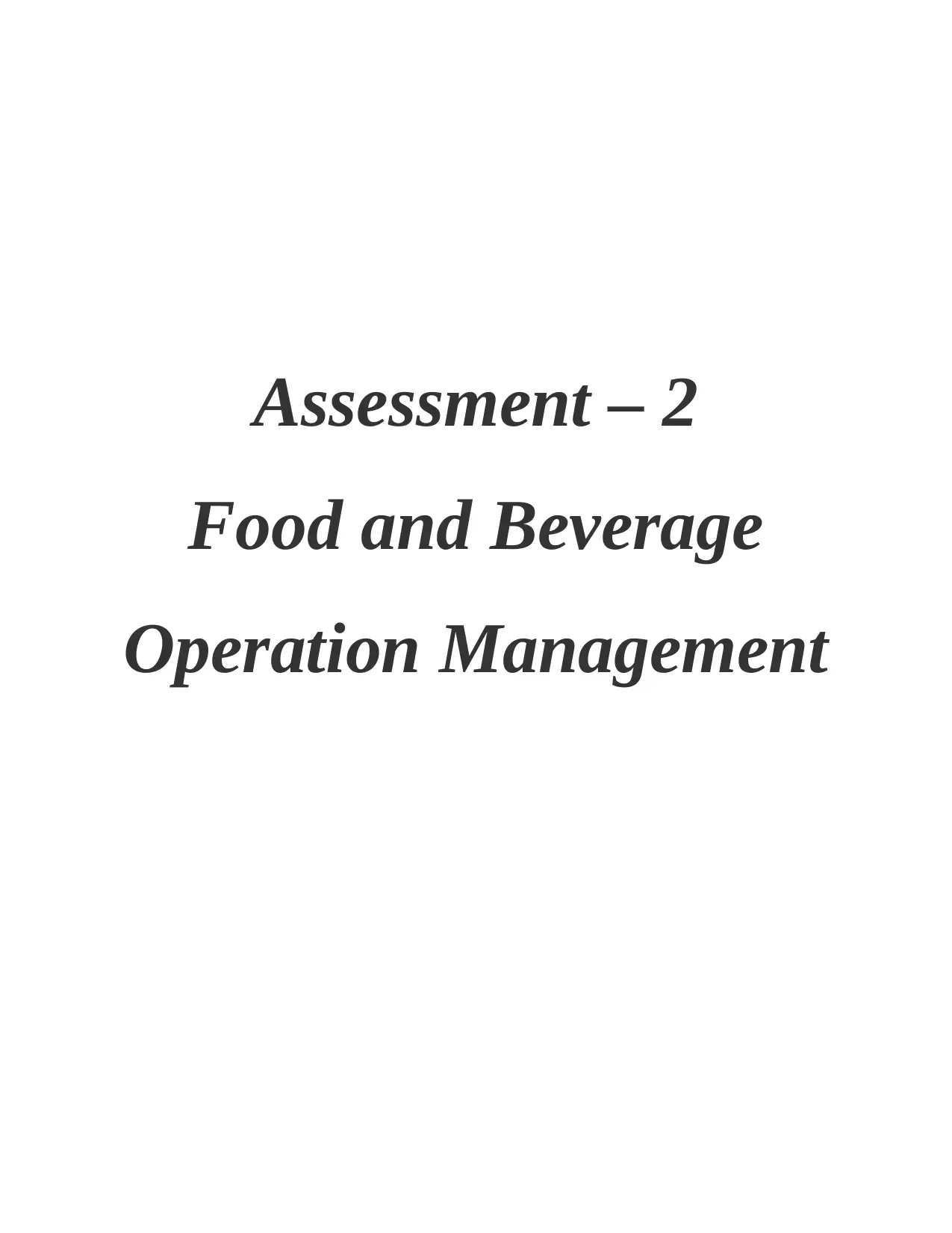
Assessment – 2
Food and Beverage
Operation Management
Food and Beverage
Operation Management
Paraphrase This Document
Need a fresh take? Get an instant paraphrase of this document with our AI Paraphraser
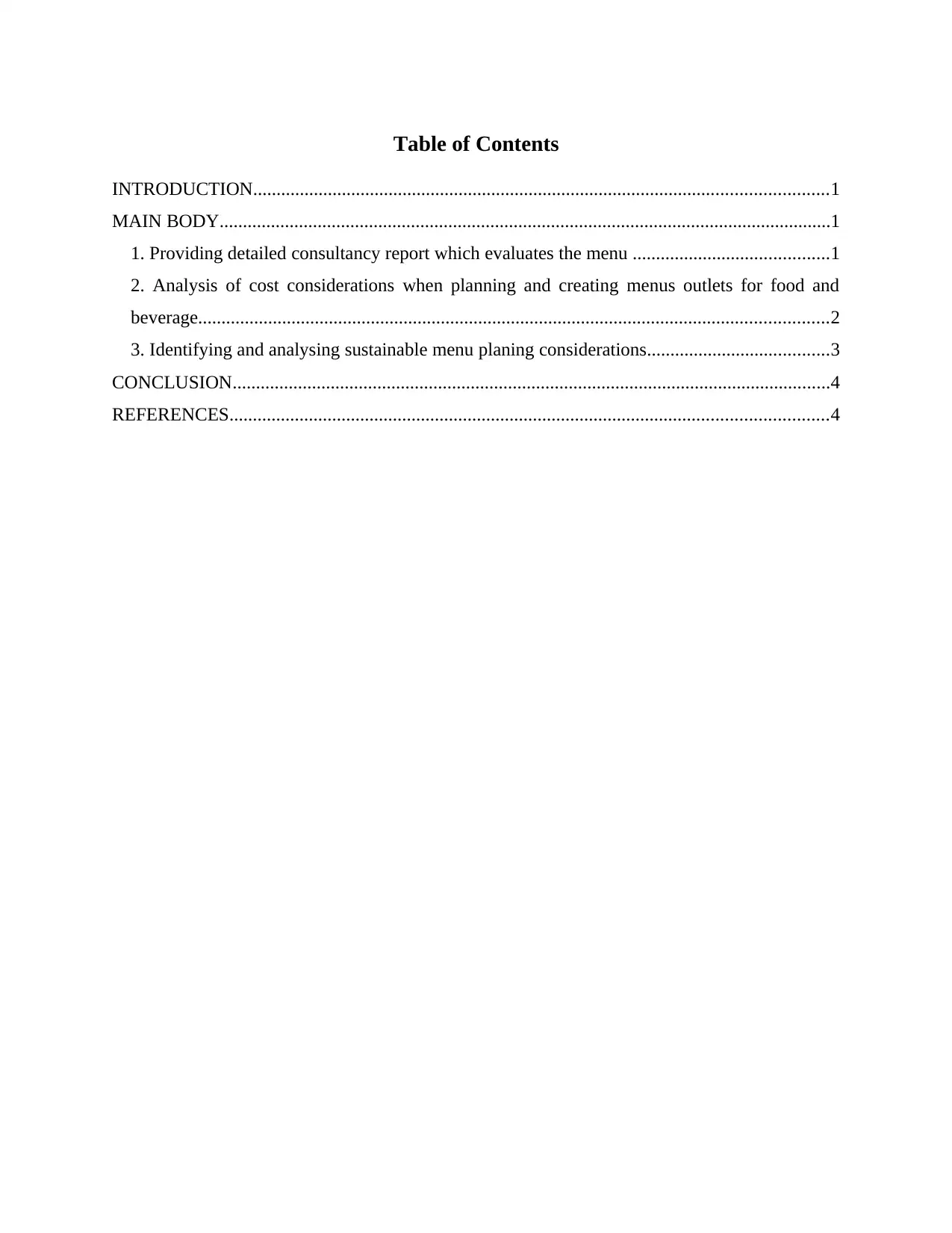
Table of Contents
INTRODUCTION...........................................................................................................................1
MAIN BODY...................................................................................................................................1
1. Providing detailed consultancy report which evaluates the menu ..........................................1
2. Analysis of cost considerations when planning and creating menus outlets for food and
beverage.......................................................................................................................................2
3. Identifying and analysing sustainable menu planing considerations.......................................3
CONCLUSION................................................................................................................................4
REFERENCES................................................................................................................................4
INTRODUCTION...........................................................................................................................1
MAIN BODY...................................................................................................................................1
1. Providing detailed consultancy report which evaluates the menu ..........................................1
2. Analysis of cost considerations when planning and creating menus outlets for food and
beverage.......................................................................................................................................2
3. Identifying and analysing sustainable menu planing considerations.......................................3
CONCLUSION................................................................................................................................4
REFERENCES................................................................................................................................4

INTRODUCTION
The menu is described as the process for list of soups, main course, desserts, salad, etc.,
specified with the cost of its producing which is charged on consumers for their satisfaction. This
project is based upon Food Facination restaurant which has graphically, creatively and
attractively designed menu (Chen and Voigt, 2020). This project consists of pricing and design
of menu followed with cost considerations while planing and creating menu. Additionally, it
analyse sustainable importance for menu planing of restaurant.
MAIN BODY
1. Providing detailed consultancy report which evaluates the menu
Menu of restaurant covers list of all the food items produced with the cost. This is
prepared to attract the mind of consumers through its creativity, most consumable dish, colour,
size and design. It is considered as the most important factor of marketing tool. The managers of
Food Facination implement menu with its attractive costing, pricing and design to position the
mind of consumers. Menus are also prepared in restaurants, hotels, weddings, etc. It is described
as under:-
Costing:- The costing is described as the estimation of expense incurred while producing
the dish. The managers of Food and Facination implement costing to determine the exact
cost implied on product which is essentially to be covered by consumers. The costing of
Food Facination is high as compared to its competitors because it produce qualitative
dish which results in high price.
Pricing:- The pricing is considered as the process to apply the price of dish on menu with
cost plus profit margin to be consumed by consumers. This leads restaurant to remain
stable and achieve success. The managers of Food Facination implement competitive
pricing strategy for its menu because they provide standardised and hygiene food with
best quality (Diekola, 2016). This increase consumer loyalty and they are ready to pay
high prices.
Designing:- The designing is referred as the procedure to develop and design menu in
attractive and creative manner with beautiful colours which helps in brand positioning of
consumers. The managers of Food Facination implement well structured design to
1
The menu is described as the process for list of soups, main course, desserts, salad, etc.,
specified with the cost of its producing which is charged on consumers for their satisfaction. This
project is based upon Food Facination restaurant which has graphically, creatively and
attractively designed menu (Chen and Voigt, 2020). This project consists of pricing and design
of menu followed with cost considerations while planing and creating menu. Additionally, it
analyse sustainable importance for menu planing of restaurant.
MAIN BODY
1. Providing detailed consultancy report which evaluates the menu
Menu of restaurant covers list of all the food items produced with the cost. This is
prepared to attract the mind of consumers through its creativity, most consumable dish, colour,
size and design. It is considered as the most important factor of marketing tool. The managers of
Food Facination implement menu with its attractive costing, pricing and design to position the
mind of consumers. Menus are also prepared in restaurants, hotels, weddings, etc. It is described
as under:-
Costing:- The costing is described as the estimation of expense incurred while producing
the dish. The managers of Food and Facination implement costing to determine the exact
cost implied on product which is essentially to be covered by consumers. The costing of
Food Facination is high as compared to its competitors because it produce qualitative
dish which results in high price.
Pricing:- The pricing is considered as the process to apply the price of dish on menu with
cost plus profit margin to be consumed by consumers. This leads restaurant to remain
stable and achieve success. The managers of Food Facination implement competitive
pricing strategy for its menu because they provide standardised and hygiene food with
best quality (Diekola, 2016). This increase consumer loyalty and they are ready to pay
high prices.
Designing:- The designing is referred as the procedure to develop and design menu in
attractive and creative manner with beautiful colours which helps in brand positioning of
consumers. The managers of Food Facination implement well structured design to
1
⊘ This is a preview!⊘
Do you want full access?
Subscribe today to unlock all pages.

Trusted by 1+ million students worldwide

highlight the special dishes of restaurant which motivates consumers with discount or
various offers of delivering dish.
Menu of Food Facination
2. Analysis of cost considerations when planning and creating menus outlets for food and
beverage
Cost consideration of menu is described as the procedure to identify the expense incurred
on various business activities which is collaborated to determine the actual cost on specific dish.
The managers of Food Facination implement this cost consideration to analyse the total cost on
various dish which is to be imposed with profit margin (Cuihua, 2014). Some of these cost are
implied by Food Facination for their planing and developing menu of food and beverage services
are as follows:-
2
various offers of delivering dish.
Menu of Food Facination
2. Analysis of cost considerations when planning and creating menus outlets for food and
beverage
Cost consideration of menu is described as the procedure to identify the expense incurred
on various business activities which is collaborated to determine the actual cost on specific dish.
The managers of Food Facination implement this cost consideration to analyse the total cost on
various dish which is to be imposed with profit margin (Cuihua, 2014). Some of these cost are
implied by Food Facination for their planing and developing menu of food and beverage services
are as follows:-
2
Paraphrase This Document
Need a fresh take? Get an instant paraphrase of this document with our AI Paraphraser
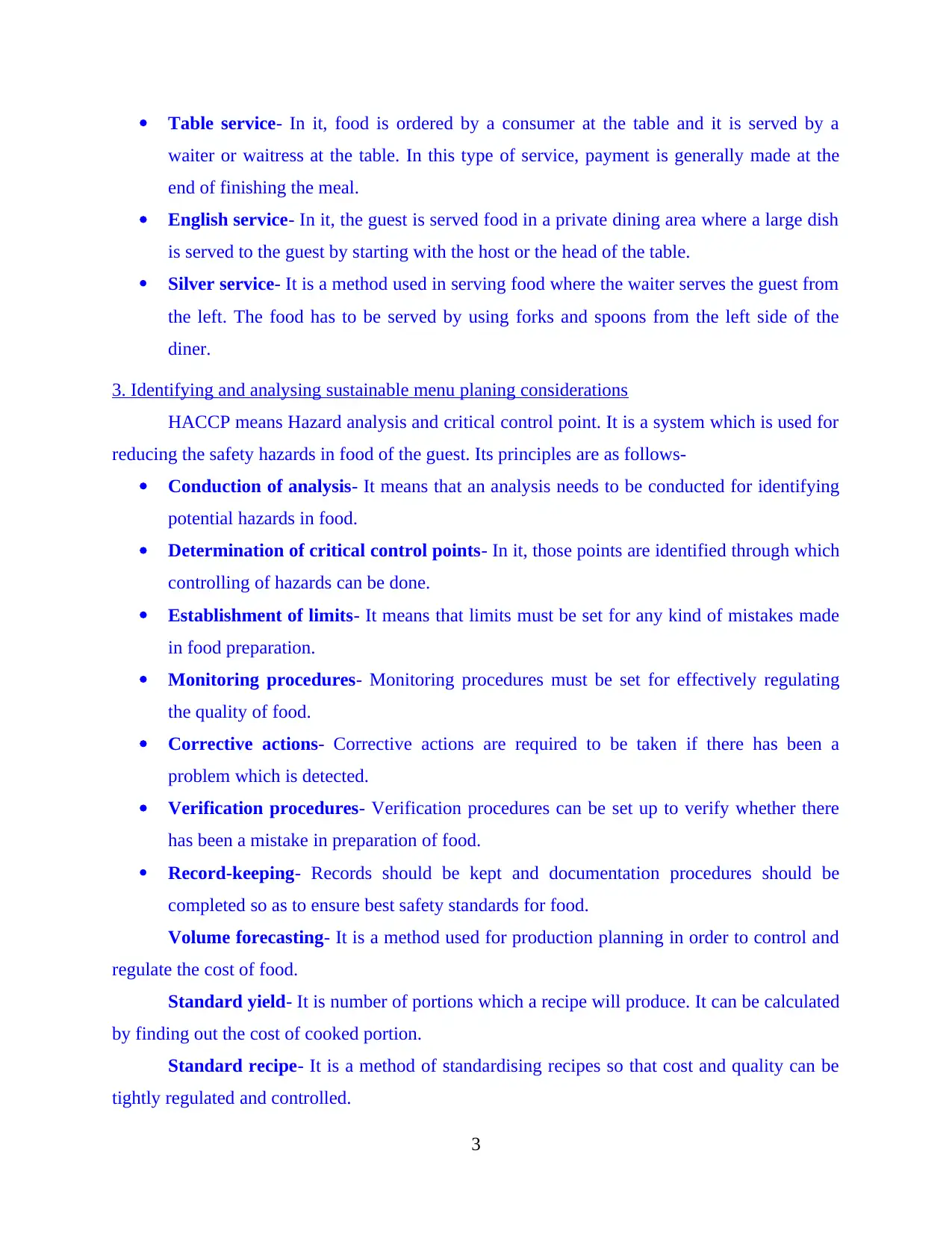
Table service- In it, food is ordered by a consumer at the table and it is served by a
waiter or waitress at the table. In this type of service, payment is generally made at the
end of finishing the meal.
English service- In it, the guest is served food in a private dining area where a large dish
is served to the guest by starting with the host or the head of the table.
Silver service- It is a method used in serving food where the waiter serves the guest from
the left. The food has to be served by using forks and spoons from the left side of the
diner.
3. Identifying and analysing sustainable menu planing considerations
HACCP means Hazard analysis and critical control point. It is a system which is used for
reducing the safety hazards in food of the guest. Its principles are as follows-
Conduction of analysis- It means that an analysis needs to be conducted for identifying
potential hazards in food.
Determination of critical control points- In it, those points are identified through which
controlling of hazards can be done.
Establishment of limits- It means that limits must be set for any kind of mistakes made
in food preparation.
Monitoring procedures- Monitoring procedures must be set for effectively regulating
the quality of food.
Corrective actions- Corrective actions are required to be taken if there has been a
problem which is detected.
Verification procedures- Verification procedures can be set up to verify whether there
has been a mistake in preparation of food.
Record-keeping- Records should be kept and documentation procedures should be
completed so as to ensure best safety standards for food.
Volume forecasting- It is a method used for production planning in order to control and
regulate the cost of food.
Standard yield- It is number of portions which a recipe will produce. It can be calculated
by finding out the cost of cooked portion.
Standard recipe- It is a method of standardising recipes so that cost and quality can be
tightly regulated and controlled.
3
waiter or waitress at the table. In this type of service, payment is generally made at the
end of finishing the meal.
English service- In it, the guest is served food in a private dining area where a large dish
is served to the guest by starting with the host or the head of the table.
Silver service- It is a method used in serving food where the waiter serves the guest from
the left. The food has to be served by using forks and spoons from the left side of the
diner.
3. Identifying and analysing sustainable menu planing considerations
HACCP means Hazard analysis and critical control point. It is a system which is used for
reducing the safety hazards in food of the guest. Its principles are as follows-
Conduction of analysis- It means that an analysis needs to be conducted for identifying
potential hazards in food.
Determination of critical control points- In it, those points are identified through which
controlling of hazards can be done.
Establishment of limits- It means that limits must be set for any kind of mistakes made
in food preparation.
Monitoring procedures- Monitoring procedures must be set for effectively regulating
the quality of food.
Corrective actions- Corrective actions are required to be taken if there has been a
problem which is detected.
Verification procedures- Verification procedures can be set up to verify whether there
has been a mistake in preparation of food.
Record-keeping- Records should be kept and documentation procedures should be
completed so as to ensure best safety standards for food.
Volume forecasting- It is a method used for production planning in order to control and
regulate the cost of food.
Standard yield- It is number of portions which a recipe will produce. It can be calculated
by finding out the cost of cooked portion.
Standard recipe- It is a method of standardising recipes so that cost and quality can be
tightly regulated and controlled.
3
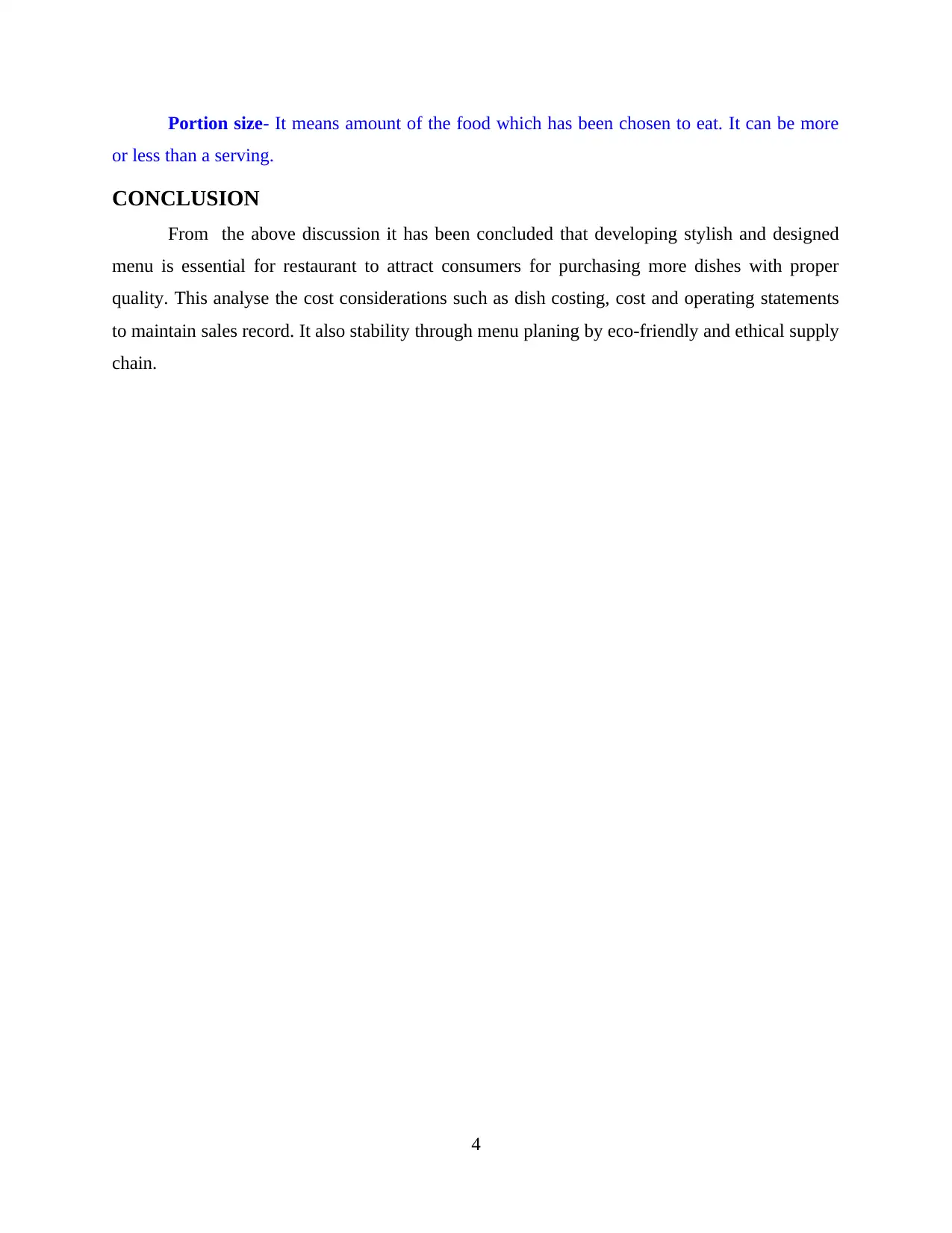
Portion size- It means amount of the food which has been chosen to eat. It can be more
or less than a serving.
CONCLUSION
From the above discussion it has been concluded that developing stylish and designed
menu is essential for restaurant to attract consumers for purchasing more dishes with proper
quality. This analyse the cost considerations such as dish costing, cost and operating statements
to maintain sales record. It also stability through menu planing by eco-friendly and ethical supply
chain.
4
or less than a serving.
CONCLUSION
From the above discussion it has been concluded that developing stylish and designed
menu is essential for restaurant to attract consumers for purchasing more dishes with proper
quality. This analyse the cost considerations such as dish costing, cost and operating statements
to maintain sales record. It also stability through menu planing by eco-friendly and ethical supply
chain.
4
⊘ This is a preview!⊘
Do you want full access?
Subscribe today to unlock all pages.

Trusted by 1+ million students worldwide
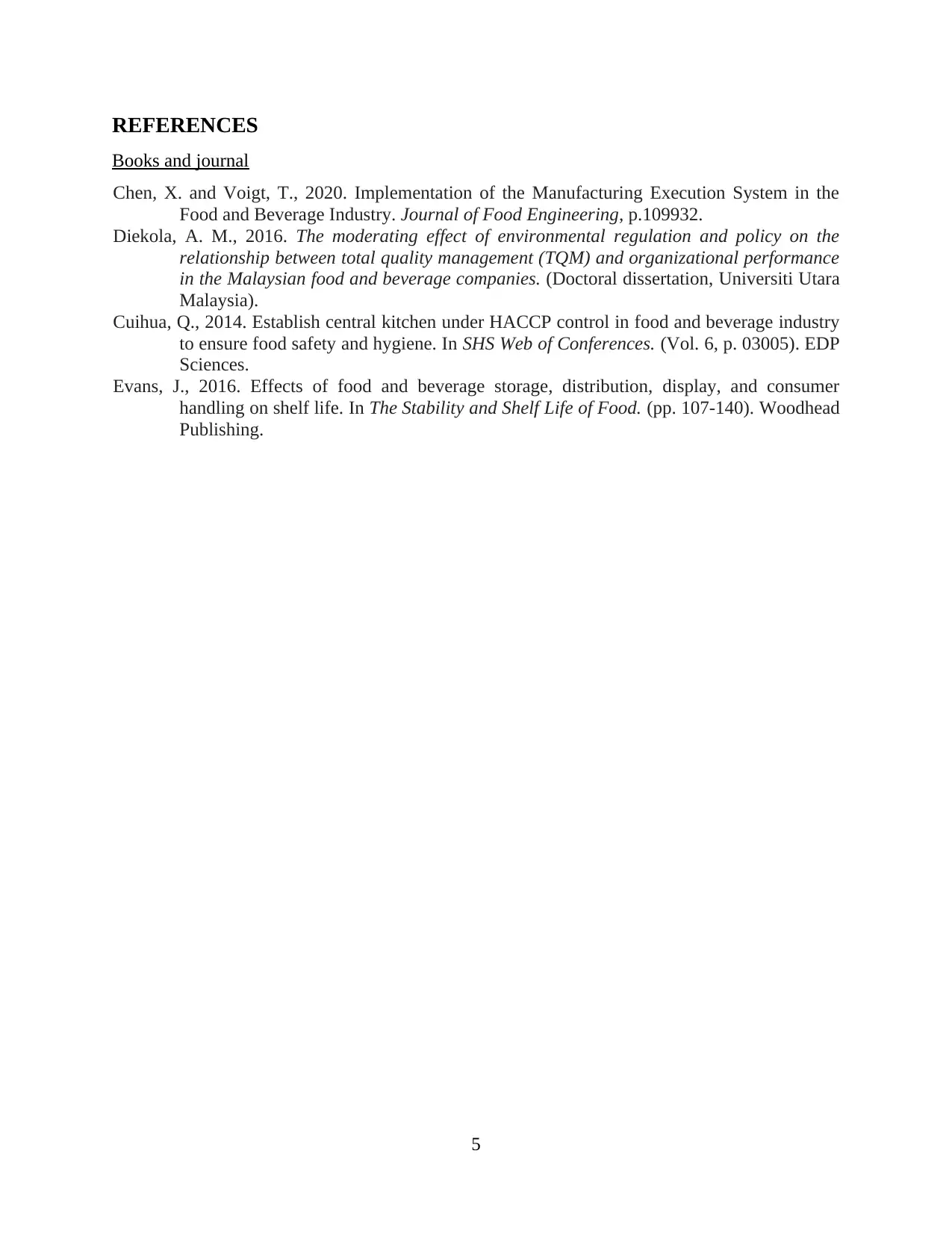
REFERENCES
Books and journal
Chen, X. and Voigt, T., 2020. Implementation of the Manufacturing Execution System in the
Food and Beverage Industry. Journal of Food Engineering, p.109932.
Diekola, A. M., 2016. The moderating effect of environmental regulation and policy on the
relationship between total quality management (TQM) and organizational performance
in the Malaysian food and beverage companies. (Doctoral dissertation, Universiti Utara
Malaysia).
Cuihua, Q., 2014. Establish central kitchen under HACCP control in food and beverage industry
to ensure food safety and hygiene. In SHS Web of Conferences. (Vol. 6, p. 03005). EDP
Sciences.
Evans, J., 2016. Effects of food and beverage storage, distribution, display, and consumer
handling on shelf life. In The Stability and Shelf Life of Food. (pp. 107-140). Woodhead
Publishing.
5
Books and journal
Chen, X. and Voigt, T., 2020. Implementation of the Manufacturing Execution System in the
Food and Beverage Industry. Journal of Food Engineering, p.109932.
Diekola, A. M., 2016. The moderating effect of environmental regulation and policy on the
relationship between total quality management (TQM) and organizational performance
in the Malaysian food and beverage companies. (Doctoral dissertation, Universiti Utara
Malaysia).
Cuihua, Q., 2014. Establish central kitchen under HACCP control in food and beverage industry
to ensure food safety and hygiene. In SHS Web of Conferences. (Vol. 6, p. 03005). EDP
Sciences.
Evans, J., 2016. Effects of food and beverage storage, distribution, display, and consumer
handling on shelf life. In The Stability and Shelf Life of Food. (pp. 107-140). Woodhead
Publishing.
5
1 out of 7
Related Documents
Your All-in-One AI-Powered Toolkit for Academic Success.
+13062052269
info@desklib.com
Available 24*7 on WhatsApp / Email
![[object Object]](/_next/static/media/star-bottom.7253800d.svg)
Unlock your academic potential
Copyright © 2020–2025 A2Z Services. All Rights Reserved. Developed and managed by ZUCOL.




